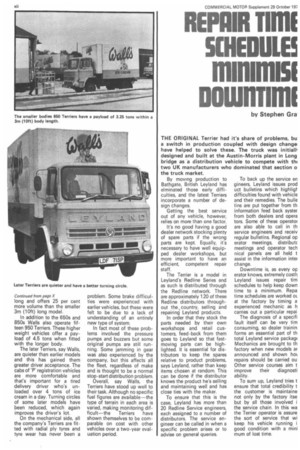wiTHin THESE WALLS
Page 54

Page 56

If you've noticed an error in this article please click here to report it so we can fix it.
by Stephen Gray FEW TYPES of operations are more punishing on a truck than urban stopstart delivery. Usually the engine has a prolonged warming up period and often never reaches its full running temperature. More frequent gear changes take their toll on the clutch and transmission, while the steering and suspension suffer from constant kerbing of the tyres.
Walls Ice Cream operate a mixed fleet of vehicles engaged in exactly this kind of work, delivering the company's products to retail and trade outlets. The vehicles cover an average of 15,000 miles each per year throughout the country, although those based in more rural areas cover slightly more miles.
Walls bought twenty 850 Terriers eighteen months after their introduction, and al though not completely problem free, these early models are still going strong. The standard 305mm (12in) clutch plate proved to be inadequate for the Walls operation, so the company specified the larger 330mm (13in) type. These are used, on the majority of the fleet, in conjunction with the six-cylinder power unit and four-speed gearbox.
However, Walls do operate some smaller 650 Terriers which are fitted with four cylinder engines. These smaller Terriers, of which Walls bought ten, have a payload of 3.25 tons when fitted with special lightweight bodywork and refrigeration equipment. All bodies for the company's fleet are designed and built by its Vehicle Engineering Division.
Two types of body are built and although made for the Walls operation, they were designed as general purpose van bodies, offering uniform load distribution. Refrigeration, all important to Walls, is by means of underslung Eutectic plates. The larger of the two bodies is 3.8m (12ft 4in) long and offers 25 per cent more volume than the smaller 3m (10ft) long model.
In addition to the 650s and 850s Walls also operate fifteen 950 Terriers. These higher weight vehicles offer a payload of 4.6 tons when fitted with the longer body.
The later Terriers, say Walls, are quieter than earlier models and this has gained them greater driver acceptance. The cabs of registration vehicles are more comfortable and that's important for a tired delivery driver who's unloaded over 4 tons of ice cream in a day. Turning circles of some later models have been reduced, which again improves the driver's lot.
On the mechanical side, all the company's Terriers are fitted with radial ply tyres and tyre wear has never been a problem. Some brake difficulties were experienced with earlier vehicles, but these were felt to be due to a lack of understanding of an entirely new type of system.
In fact most of these problems involved the pressure pumps and buzzers but some original pumps are still running. Some jamming in gear was also experienced by the company, but this affects all the fleet, regardless of make and is thought to be a normal stop-start distribution problem.
Overall, say Walls, the Terriers have stood up well to their task. Although no specific fuel figures are available—the type of terrain in each area is varied, making monitoring difficult—the Terriers have shown themselves to be comparable on cost with other vehicles over a two-year evaluation period.








































































































